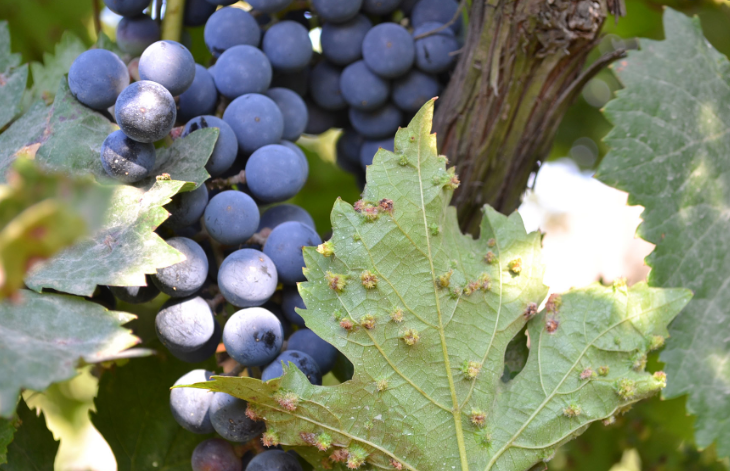A century and a half ago an alien insect alighted in Europe.
一个半世纪以前,一种外来昆虫飞落欧洲。
It displaced millions, ruined local economies and forced scientists, politicians and ordinary folk into a frenzy of defensive activity.
它让数百万人流离失所,对当地经济造成破坏,还迫使科学家、政治家和普通民众陷入疯狂的防御活动。
Phylloxera, a member of the group known to entomologists as Hemiptera, or "true" bugs
根瘤蚜虫,昆虫学家口中半翅目家族的一员,或称真虫
(as opposed to all the other critters known colloquially as bugs),
(与所有其他他俗称虫子的生物截然相反),
appeared in France in the 1860s and proceeded to eat its way through many of the Old World's vines.
于19世纪60年代出现在法国,并逐渐侵蚀了许多旧世界的葡萄藤。
It then spread to pastures new. It was first recorded in Australia in 1875 and in South Africa in 1886,
然后蔓延到新的地方。最早的记录是在1875年的澳大利亚以及1886年的南非,
threatening similar devastation to the vineyards of those European colonies.
对欧洲殖民地的葡萄园造成了类似的破坏威胁。
Eventually, French and American scientists found a solution by grafting European vines onto the imported roots of American ones.
最终,法国和美国科学家找到了一个解决办法,他们把欧洲的葡萄藤嫁接到美国葡萄藤的根上。
Now, a more recent group of French and American researchers report in BMC Biology that they have sequenced phylloxera's genome,
近期,法美研究团队在《BMC Biology》上报告称,他们对根瘤蚜虫的基因组进行了排序,
and that hidden within this lie clues to the insect's origins and spread.
并且基因组中隐藏着这种昆虫起源和传播的线索。

根瘤蚜虫(1)
Nineteenth-century agronomists rapidly divined that phylloxera had come from North America.
19世纪的农学家迅速推断称,根瘤蚜虫来自北美。
That fact provided the rationale behind their graft-based answer to the problem—which is still all that stands between cultivated vines and the bug.
这一事实为他们通过嫁接解决问题提供了理论基础——这个问题仍是种植葡萄与这种昆虫之间的唯一障碍。
This is that having co-evolved with the insect, American vines had developed resistance to it.
也就是说,在与这种昆虫共同进化的过程中,美国的葡萄树已经对它产生了抗性。
But where exactly it came from on that continent, nobody knew.
但是,没有人知道这种昆虫到底来自那个大陆的哪个地方。
One theory held British gardeners responsible because they had brought wild American vines to Europe for decorative purposes.
一种理论认为英国园丁因为此负责,因为他们将野生美国葡萄藤作为装饰品带到了欧洲。
From Britain, this theory went, phylloxera reached the European mainland via the south of France, the first place where it devastated vineyards.
该理论认为,根瘤蚜虫从英国经法国南部传入欧洲大陆。它首先是破坏了法国的葡萄园。
That, though, turns out to be a calumny against les Anglais.
但事实证明,这是对英国人的诽谤。
By comparing the genetic sequence of European phylloxera with those of populations from wild vines in the United States,
通过将欧洲根瘤蚜虫的基因序列与美国野生葡萄藤的种群的基因序列进行对比,
Claude Rispe and Fabrice Legeai of the French National Research Institute for Agriculture, Food and the Environment (INRAE)
来自法国国家农业、食品和环境研究所(INRAE)的Claude Rispe和Fabrice Legeai
and their colleagues have narrowed the search to the once-French territory of the Mississippi Valley
以及他们的同事将研究范围搜索范围缩小到曾经属于法国的密西西比河谷
(the upper Mississippi, to be precise—though one of the paper's authors,
(准确的说是,上密西西比河——虽然该论文的作者之一,
Paul Nabity of the University of California, Riverside, plans to keep following the river south, sampling phylloxera as he goes, so the matter is not closed).
美国加州大学河滨分校的Paul Nabity计划继续沿着河流南下,对根瘤蚜进行取样,所以这个任务还没结束)。
The evidence is that there is a striking similarity between the European sequence
证据表明,欧洲基因序列与野生葡萄藤——河岸葡萄——
and that of two phylloxera populations on a wild vine called Vitis riparia in Wisconsin and Illinois.
的两个根瘤蚜虫群(分别在威斯康星州和伊利诺斯州)的基因序列之间存在惊人的相似性。
This is enough, Dr Nabity says, to indicate that V. riparia was the bug's original host and the upper Midwest its source.
Nabity博士表示,这就足以证明河岸葡萄是这种昆虫的原宿主,上中西部地区是其源头。
来源:经济学人

参与评论